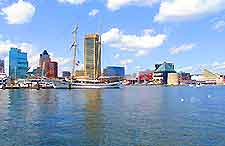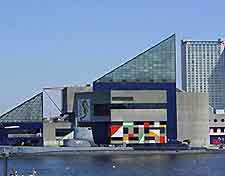Baltimore History Facts and Timeline
(Baltimore, Maryland - MD, USA)

The largest seaport along the Mid-Atlantic coastline of the United States, the city of Baltimore was once an important port of entry for immigrants, second only to
New York. Founded in 1729, its initial purpose was as a hub for the tobacco trade, and growth was swift in connection with the booming Caribbean sugar trade.
Revolution and Unrest
The history of Baltimore was shaped by the events leading up to the American War of Independence (1775 to 1783), with local merchants and businessmen incensed by the increasing burden of taxation imposed by the British, to the extent that many banded together to sign agreements banning trade with Britain. After the revolution succeeded, neighboring Jonestown and Fells Point were incorporated into the urban area in 1796, with Baltimore itself incorporated as a city in Baltimore County at the same time.
The 19th Century
War with Britain broke out again in 1812 as part of the French-British War, with English forces landing on American soil in an attempt to regain the control lost after the War of Independence. After
Washington was razed to the ground, the British turned their interests to Baltimore and attacked in 1814 during the night of 13th September, although American troops stationed at Fort Henry beat them back and prevented the capture of the harbor.
On hand at the time of this important battle in the history of Baltimore was Maryland lawyer Francis Scott Key. When news of this victory reached him, he penned a poem. This poem, the Star-Spangled Banner, later became the national anthem of America and was set to music created by British composer John Stafford Smith.
[

TITLE2]Post-War Expansion and Civil War History
Following the end of these hostilities, the population of the city rapidly expanded, with the construction of a national road and the Baltimore and Ohio Railroad, with the first section of the latter opening in 1830. The city once again became an important manufacturing and shipping center due to its improved transportation links to major markets. The city's unique skyline began to take shape, with church spires and tall monuments reflecting the developing and distinctive local culture.
During the Civil War (1861 to 1865), Baltimore residents took stands both for and against slavery, although the state of Maryland didn't secede from the Union at the time. When the Union Army marched through the city, it was attacked by Confederate supporters, sparking riots and resulting in the seizing of the city by Union forces.
The 20th Century
The new century began badly for Baltimore, with 70 blocks in the downtown district destroyed by the Great Baltimore Fire in 1904. Rebuilding took two years at a cost of US$150 million, with improvements in the standards of fire protection ensuring the future of the new developments. With nearly half of the population now African-American, another riot took place in 1968 following the assassination of Martin Luther King, taking over a week to be contained, causing US$10 million worth of damage and involving some 11,000 National Guard troops.
From the late 1970s onwards, the Inner Harbor area, previously allowed to become run-down and somewhat decrepit, underwent a massive redevelopment initiative. The district is now a major tourism and convention destination in Baltimore, with a museum, convention center and an aquarium. A plenitude of retail, restaurant and entertainment venues are on offer here, and just minutes away are top baseball and American football stadiums.
 The largest seaport along the Mid-Atlantic coastline of the United States, the city of Baltimore was once an important port of entry for immigrants, second only to New York. Founded in 1729, its initial purpose was as a hub for the tobacco trade, and growth was swift in connection with the booming Caribbean sugar trade.
The largest seaport along the Mid-Atlantic coastline of the United States, the city of Baltimore was once an important port of entry for immigrants, second only to New York. Founded in 1729, its initial purpose was as a hub for the tobacco trade, and growth was swift in connection with the booming Caribbean sugar trade.